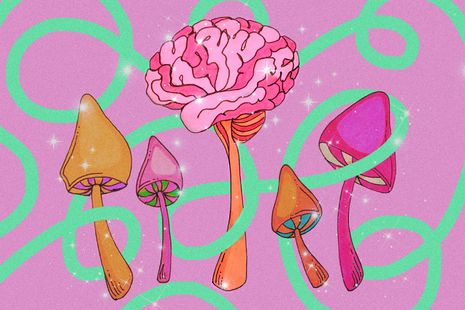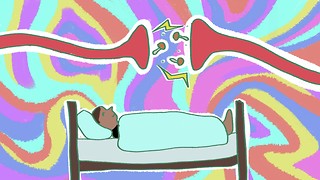What can magic mushrooms do for Parkinson’s disease?
Lucy George explains how ‘shrooms’ have clinical potenital against the neurodegenerative disorder

Psilocybin mushrooms, better known as magic mushrooms or ‘shrooms’, have been widely known for their hallucinogenic properties since as early as the 16th century. From their origins as the mysterious, sacred mushrooms of Central America to their current status as prohibited but recreationally abused drugs in the UK, the history of magic mushroom use has provided fascinating insights into their effects on the human brain. An unexpected revelation from a recent clinical trial has sparked great excitement for the clinical use of magic mushrooms in patients with Parkinson’s Disease – but how do magic mushrooms exert their ‘magic’ effects on the brain, and in potential treatments for neurodegenerative disease?
Psilocybin, the active component of magic mushrooms, is thought to provide these recreational drugs with their mystical properties through its conversion into psilocin, which binds to a specific receptor in the brain for serotonin: a hormone involved in ‘mood boosting’, among many other functions. Studies have suggested that psilocybin’s impact on the brain is to disrupt the normal connections between neurones in ‘brain hubs’, which are critical for cognitive functions such as abstract thought, attention and memory. The reduced activity in these brain hubs during the use of psilocybin is thought to allow the user to enter into a state of unhindered cognition, leading to the sensory distortion and altered state of consciousness associated with psychedelic substance abuse.
“Psilocybin reduces brain inflammation in Parkinson’s sufferers”
However, the aim of psilocybin administration in patients with Parkinson’s disease is quite distinct from that of recreational drug users. The recent clinical trial investigating the use of psilocybin therapy in Parkinson’s patients aimed to show a reversal of motor dysfunction characteristic of this neurodegenerative disease, while also treating the mood dysfunction which often precedes the development of motor symptoms such as tremors and muscle stiffness.
Although poorly understood, it is thought that once converted into psilocin, psilocybin reduces the brain inflammation seen in disease sufferers, while also promoting a burst of nerve cell growth, restructuring the brain’s architecture by forming new connections between nerve cells. This provides different outcomes to those of recreational drug users because Parkinson’s patients show a significant loss of nerve cells in the brain that produce dopamine, the chemical messenger involved in regulating our movements, emotions and memories. Patients also tend to show an elevated amount of serotonin removal from the body, allowing for psilocybin to increase serotonin signalling in the brain through binding to its receptor, improving symptoms of depression.
“Currently, there is no cure for Parkinson’s Disease”
How likely is it that magic mushroom therapy will provide a breakthrough for the treatment of Parkinson’s Disease? While the 12 participants of the psilocybin trial experienced significant and rapid improvements to both motor and non-motor symptoms of the disease, persisting for a month after the final administration of psilocybin, it is difficult to draw conclusions from such a small sample size. Additionally, study participants were chosen for their absence of psychotic symptoms prior to psilocybin therapy, which raises the question: could magic mushroom therapy induce further hallucinatory symptoms in Parkinson’s patients already suffering from psychosis?
The lack of ethnic diversity across participants in the trial (as is typical for many pharmacological studies) also provides further uncertainty as to whether the effectiveness of psilocybin will be reflected in more representative populations of Parkinson’s patients in future trials. Furthermore, the study used psilocybin therapy in combination with psychotherapy sessions – this makes it difficult to attribute improvements in symptoms to psilocybin alone.
There is still no cure for Parkinson’s Disease. The underlying causes of dopamine nerve cell death in the brain are poorly understood, and as a result, current treatments focus on improving the symptoms of Parkinson’s and maintaining a high quality of life for patients suffering from this disease. While psilocybin therapy for Parkinson’s shows promising results for improving symptoms of depression and motor dysfunction in the early stages of disease progression, it is yet another example of a therapy that fails to treat its underlying cause.
This does not mean that psilocybin therapy is a ‘dead end’ in the treatment of Parkinson’s – the more drugs available for this disease, the more opportunities there are for patients to receive treatments best suited to managing their individual symptoms. The hope is that further clinical trials will continue to show the beneficial effects of psilocybin therapy in a wider representation of Parkinson’s patients, while research progresses towards finding an eventual cure.
 Features / Should I stay or should I go? Cambridge students and alumni reflect on how their memories stay with them15 December 2025
Features / Should I stay or should I go? Cambridge students and alumni reflect on how their memories stay with them15 December 2025 News / Cambridge study finds students learn better with notes than AI13 December 2025
News / Cambridge study finds students learn better with notes than AI13 December 2025 Comment / The magic of an eight-week term15 December 2025
Comment / The magic of an eight-week term15 December 2025 News / News In Brief: Michaelmas marriages, monogamous mammals, and messaging manipulation15 December 2025
News / News In Brief: Michaelmas marriages, monogamous mammals, and messaging manipulation15 December 2025 News / Uni Scout and Guide Club affirms trans inclusion 12 December 2025
News / Uni Scout and Guide Club affirms trans inclusion 12 December 2025










